
How to compost at home
I love keeping a backyard compost bin. It’s like magic. You dump in a bunch of waste, wave your wand/shovel, and voila! Out comes beautiful, rich soil loaded with beneficial nutrients and packed with earthworms.
I think of it like frugal fertilizer; plants are crazy about it.
Compost improves the soil’s structure and moisture retention, while slowly releasing into the soil to boost the plant’s growth and ability to fight diseases.
However, if there was an award for World’s Laziest Composter, I would be in serious medal contention. I love the results of a backyard compost bin, but I don’t have the time or desire to make it into a complicated process. Judging from the results we get, our mostly hands-off strategy is working just fine. From what I have read, this seems to be true for most gardeners.
My husband, Ed, built our compost bin out of wood pallets he scavenged from work, of course, so it didn’t cost a dime. Two years ago, we tried creating a tumbler compost bin (it looked exactly like this one). Because it was enclosed, it turned into a soupy, smelly sludge. Ugh. FYI: Just because it’s on Pinterest doesn’t mean it’s a good idea.
Maybe it’s a personal preference thing, but I definitely think the open bins are easier/better. Unless you live on a city lot or have issues with pesky animals, then by all means, tumble away.
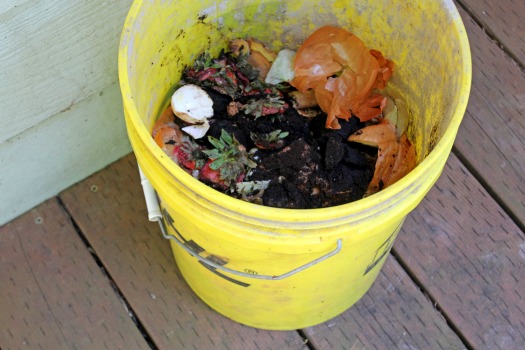
We keep our compost bin in a backyard corner near our garden and add kitchen scraps, grass clippings, and yard debris. For food scraps, I simply keep a lidded container in my kitchen sink, which I empty into a 10-gallon bucket on the back deck when full. Between juicing and eating a primarily vegetable-based diet, our family easily fills 1-2 buckets a week with food scraps.
I don’t add meat or oily/salty foods, as they take longer to decompose and can attract unwanted visitors. Animal manure from chickens, goats, or horses makes a great addition to any compost pile, but do not add poo from dogs or cats. And don’t even get me started on humanure. Yes, it’s a thing. That my husband was talking about AT DINNER the other night. Again, our poor children.
Anyway, when the bucket is full, it gets dumped in the big compost bin. We turn it occasionally to work in the newer material, keep things moist, and help break everything down. We have never needed to add water, but that’s an option if the mixture gets too dry.
Once the organic matter completely decomposes, we work it into our raised garden beds or around plants that just need a little encouragement. I also work in a healthy scoop of compost to the soil anytime I am starting new plants.
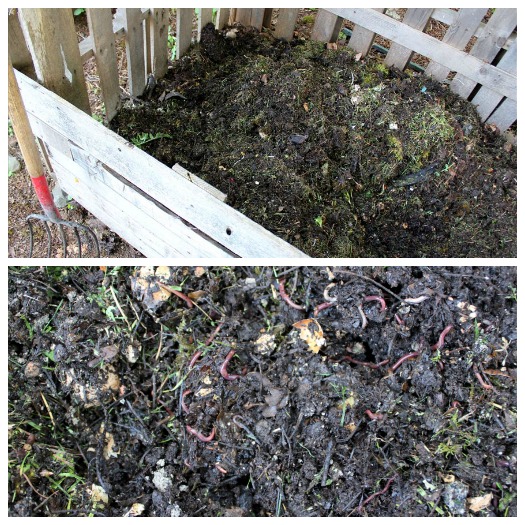
When it comes to adding organic matter to your compost bin, the standard ratio is “two parts brown to one part green.” The browns are dry material like leaves and the greens are wet materials like grass clippings or kitchen waste.
This ratio is a good rule of thumb, but it’s not crucial to the success of your compost bin. In the long run, any pile of organic material will eventually decompose, so I just try to keep a nice balance, make sure it stays moist, and let nature take its course.
If your compost pile/bin has an overly offensive odor, that’s a sign that it is too wet or has too many green materials. Mix in some dry leaves or other yard debris to balance things out. One reason some gardeners keep careful tabs on their compost is to create “hot” compost, which “cooks” quickly as it decomposes thanks to the bacteria breaking down the nitrogen-rich materials.
However, science seems to support my laziness once again because cured compost, which is covered for several months, actually has more diverse microorganisms and bacteria. I even read one suggestion to fill garbage bags with sifted compost in the fall and allow it to cure until you are ready to plant in the spring. I might give that a shot, but for now my lazy bones are happy with the results from slow, “cold” compost.
One thing I have gone back and forth on is what to do with weeds. We live on a 3/4-acre lot with no yard debris garbage service so the battle against weeds is constant. Some people just pile it into their compost bin. If the compost gets hot enough to cook the weeds, this shouldn’t be a problem. However, if not you might be reintroducing those weed seeds to your garden. Not cool.
According to Mother Earth News, one solution is to keep weeds in a separate pile before cooking them in a little “solar oven.” Simply put the weeds in a clear garbage bag in a foil-lined box placed in a sunny spot and “cook” them at 140-degrees for at least 2 hours. Foil + sun? Ed lives for that combination. Since we don’t have any kind of yard debris garbage service, this is going to be my new plan of attack.
However you do it, tumbler or bin, hot or cold, simple or complicated, one thing is certain: Compost is an easy, inexpensive way to improve the quality of your soil and give your plants important nutrients. Start saving those scraps and get your hands dirty!
*****************************************
While an old lidded yogurt container does the job, I would definitely prefer the clean look of this Oxo Good Grips Compost Bin (Amazon) on my kitchen counter. This durable bin holds about one gallon and is easy to clean (dishwasher safe!).
Want more garden inspiration? Check out these great posts:
Follow our garden board on Pinterest for more garden tips and tricks.
Find more gardening posts here.
This post may contain affiliate links. See the disclosure policy for more information.
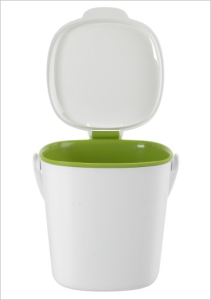
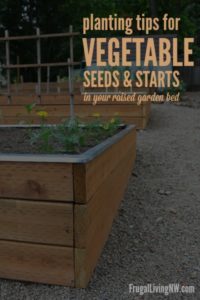
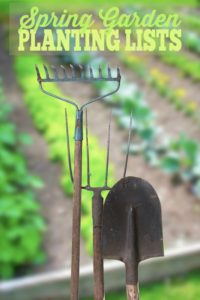
We just moved into our first house which means I can finally get this green thumb in that dirt! This article was really helpful to me, as I’m almost completely “Yard Debris”illiterate and my mom just gave me a spare yard debris container she had. Thank you so much! I will be reading all that I can on this site
I have also read that adding rabbit Alfalfia rabbit pellets helps to stimulate compost break down.
I even got a book from Amazon on using liquid gold or urine. Don’t laugh its used in many foreign countries and theres even a research center to study and improve the use of urine for fertilizer. For those that want to know its collected and sealed from air and left till its stale and then mixed with water and added to plants. My wife is less progressive with the idea so I terminated my experiments with it.
I have plans of planting a Duchess of Oldenburg apple tree and a sweet sixteen in the spring so to prepare the planting sites I grabbed my hand auger ice fishing hole digger and dug three 4 ft. deep holes at each site so they encircled the apple trees location and I filled them with compost and compress it. I topped it off with the dirt from the hole. You can find old hand ice augers at garage sales and I use them to dig fence post holes. They work fine with old blades on them.
I also use the ice fishing auger to add air to my aging compost. I just dig holes it it and lift the hole contents to the top. I never would own a clam hole digger. I just find them physically demanding.
Since you keep your compost all in one bin, how do you know when some of it is ready to use? Do you just sift through it? Also, how about when it rains, do you cover your pile?
What about paper, dryer lint, used up rags…
I googled your question and found this list.
The Composting “In” List:
Animal manure (not dog or cat)
Cardboard rolls
Clean paper
Shredded paper and newspaper
Coffee grounds and filters
Cotton rags
Dryer and vacuum cleaner lint
Eggshells
Feathers
Fireplace ashes
Fruits and vegetables
Grass clippings
Yard trimmings
Leaves
Garden residue
Hair and fur
Hay and straw
Houseplants
Leaves
Peanut hulls (these compost quickly)
Sawdust
Tea bags
Wood chips
Wool rags
Tea bags
Bonemeal
Buckwheat hulls
Corncobs
Aquarium waste water (moisten compost pile)
Pine needles (best shredded before adding to compost)
I feel your pain watching that stuff get thrown away. And also fall into the lazy composter category. Glad to know I am not alone!
I have a small orchard of fruit trees and a small vegetable garden.
When my vegetable scraps accumulate, I merely carry them out to the orchard or the garden, use a pick-ax to create a disturbance in the soil, dump my scraps into it, and pull some of the disturbed soil over the scraps. Beautiful, rich soil in no time. I select a different location to do this each time, so there’s no need to spread the compost; it’s already in the spot where it’s needed.
I think I can take away the “laziest composter” award! Over the winter I have just been throwing my vegetable/fruit/egg shell scraps in my garden & I put a bunch of leaves on it last fall (really helps to keep the weeds down over the winter). It is amazing how fast it all breaks down-I just rototilled today & there were only a few evidences of what I had put on there (& I had quite a bit also-covered it all several times) & those I just rototilled under.
A bit in my defense, I used to have the upright black composter-but the ants invaded it big time (I also was very poor about mixing it up like you are supposed to!).
I have garbage service once a month but weekly recycling/yard debris. Because of that we recycle as much as possible. Now that I’ve gotten the family better at recycling I decided that I’d try composting again and this time I decided to make an area behind our house specifically for composting instead of trying the container with holes, newspaper etc. It is so easy! I takes about 30 minutes out of my week. Once a week I empty the fruit/vegie/egg shells in the dirt and sort of stir it up. No roaming animal has taken interest in this pile of scraps. No odors (although I don’t hang out at the back side of our garden area.) I like the idea of building a little white picket fence around it and think I’ll make that my project…thanx Emily and you’re right about Pinterest.
I have zero love for weeds but just for kicks I might try the clear plastic bag in a foil lined box.